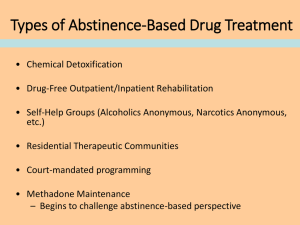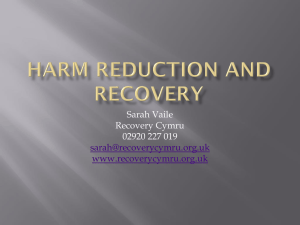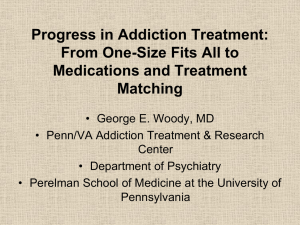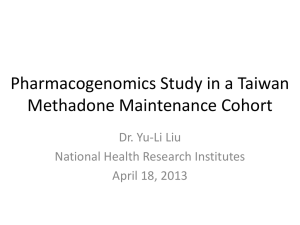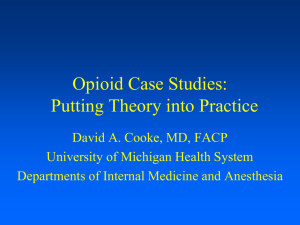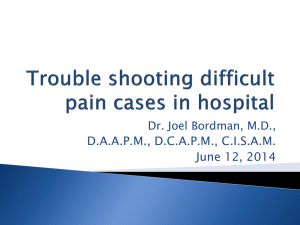Module 7: Recovery-Oriented Methadone Maintenance
advertisement
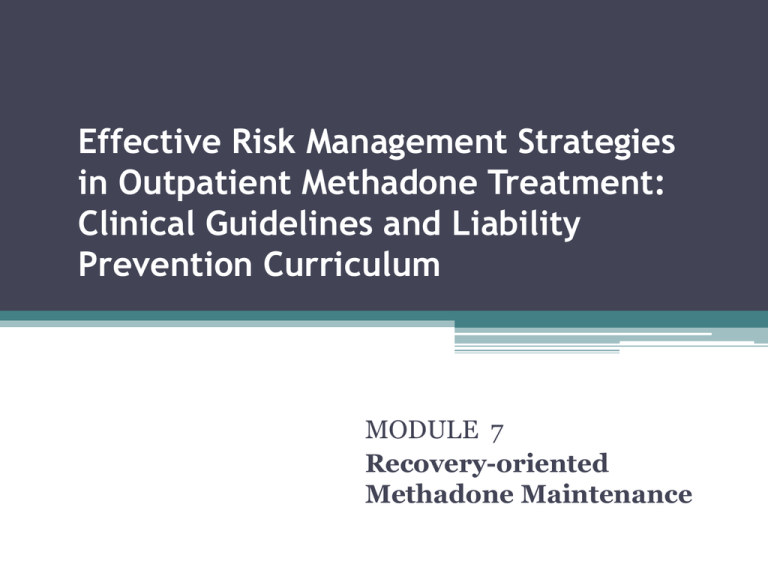
Effective Risk Management Strategies in Outpatient Methadone Treatment: Clinical Guidelines and Liability Prevention Curriculum MODULE 7 Recovery-oriented Methadone Maintenance Relevance to Risk Management • ROMM is recognized as high quality medical / clinical care • SAMSHSA focus as a model, “standard of care”, Recovery-Oriented-Systems-of-Care (ROSC) • Peer-based recovery support and more involvement of patient advocacy • Risk management principles and strategies Learning Objectives 1. Define and discuss ROMM 2. Report at least 4 milestones in the history of medicationassisted treatment of opioid addiction 3. Define “recovery” in the context of ROMM 4. Identify at least 5 changes in service practices within ROMM 5. Discuss 3 broad strategies for reducing stigma attached to medication-assisted treatment of opioid addiction Recovery-oriented methadone maintenance Recovery-oriented methadone maintenance (ROMM) is an approach to the treatment of opioid addiction that combines methadone pharmacotherapy and a sustained menu of professional and peer-based recovery support services to assist patients and families in initiating and maintaining long-term addiction recovery (White & Torres, 2010). Methadone Maintenance Milestones Ineffectiveness of pre-MM treatment of opioid addiction 1964: MM introduced by Drs. Dole, Nyswander & Kreek * Early recovery orientation MM regulation & diffusion in 1970s and 1980s MM Critics & Backlash Methadone Maintenance Milestones MM revitalization since 1990s * Scientific re-validation * Quality improvement within OTPS * Medication alternatives * Continued challenges of stigma Rise of MAT patient advocacy Calls for ROMM Medication and Recovery Status Growing consensus that: • Recovery is more than intent to stop drug use • Recovery is more than absence of drug use • Recovery is both a process and a status Recovery Definition Multiple consensus efforts have defined three central components to recovery from severe substance use disorders: 1) sobriety/abstinence/remission 2) progress towards global health 3) positive community reintegration Recovery and Methadone and Buprenorphine “…formerly opioid-dependent individuals who take naltrexone, buprenorphine, or methadone as prescribed and are abstinent from alcohol and all other nonprescribed drugs would meet this definition of sobriety.” Betty Ford Institute Consensus Panel Distinction between Physical Dependence and Addiction “The stabilized methadone maintenance patient— here defined as the patient who does not use alcohol or illicit drugs and takes methadone and other prescribed drugs only as indicated by competent medical practitioners—does not, meet key definitional criteria for addiction (e.g., obsession with using, loss of volitional control over use, self-accelerating patterns of use, compulsive use in spite of escalating consequences).” (White & Torres, 2010) Recovery and MM Practices • Achieving this vision of recovery as remission, global health, and citizenship for the mass of MM patients will require expanding and elevating the range and quality of clinical and peer-based recovery support services available to MM patients and their families. • It will also require creating the physical, psychological, and cultural space in local communities within which medication-assisted recovery can flourish. ROMM & Changing Service Practices 8 arenas of service practice will be profoundly transformed in the move toward ROMM: 1) Assessment and service planning 2) Service team composition 3) Service relationships 4) Attraction, access, and early engagement ROMM & Changing Service Practices 5) Service quality and duration 6) Locus of service delivery 7) Assertive linkage to recovery community resources 8) Long-term recovery check-ups, stageappropriate recovery support, and when needed, early re-intervention Sample ROMM practices related to Access, Engagement & Retention • • • • • • • Expansion of treatment capacity Assertive waiting list management Assertive outreach Personally optimum medication doses Mobilization of family/kinship support Peer-based Recovery Coaching Expanded ancillary services Sample ROMM Practices Related to Assessment and Service Planning • • • • Use of global assessment instruments Assessment as a continual vs. intake process Family as the unit of service Transitioning from treatment plans to recovery plans Sample ROMM Practices Related to Composition of the Service Team • Expanded role for physicians • Access to family/child therapists • Greater use of peers in recovery in paid and volunteer support positions • Greater involvement of indigenous helpers Sample ROMM Practices Related to Service Relationships • • • • Recovery representation Respect for patient opinions and preferences Changes in administrative discharge policies Focus on elevating patient hopes and possibilities • Use of patient-directed recovery plans • Emphasis on sustained continuity of contact and support across the stages of long-term recovery Sample ROMM Practices Related to Service Quality and Duration 1) Assuring safe induction via dosing policies 2) Providing recovery-focused addiction counseling 3) Providing ancillary resources for co-occurring problems and needs of the patients’ families/children 4) Extending the average length of duration of MM treatment (at least 1-2 years to achieve the best longterm recovery outcomes) 5) Increasing the percentage of MM patients who either sustain or successfully complete treatment 6) Building a strong culture of recovery Sample ROMM Practices Related to the Locus of Service Delivery • Increasing access to medication in non-OTP treatment and recovery support sites • Expanding office-based treatment and medical maintenance • Greater use of neighborhood- and home-based recovery support services Sample ROMM Practices Related to Linkage to Recovery Communities • Liaison with local mutual aid service committees • Supporting development of groups specifically for persons in medication-assisted recovery • Assertive linkage of patients to the recovery community resources • Volunteer or paid peer recovery coaching on how to address medication at recovery support meetings • Visible participation in local recovery celebration events ROMM Practices Related to Post-Treatment Support • Post-treatment recovery check-ups regardless of discharge status • Access to peer-based recovery support • Stage-appropriate recovery education • Continued assertive linkage to recovery community resources • Early reintervention, if and when needed Stigma as an Obstacle to ROMM Implementation The social and professional stigma attached to MM leaves the MM patient facing: ▫ ▫ ▫ ▫ Challenges to their recovery status Pressure to end MM as soon as possible Family and social isolation Discrimination related to housing, employment, and access to health care and other forms of addiction treatment & recovery support services Stigma-related Assumptions about MM Unsupported by Science and Clinical Experience 1) Addiction is a choice. 2) Methadone simply replaces one drug/addiction for another. 3) Methadone maintenance prolongs rather than shortens addiction careers. 4) Low doses and short periods of methadone maintenance result in better rates of long-term recovery. 5) Methadone maintenance patients should be encouraged to end methadone treatment as soon as possible. Strategies to Address Professional and Social Stigma 1) Personal or mass protest (advocacy) 2) Public and professional education 3) Strategies that increase interpersonal contact between stigmatized and non-stigmatized groups ROMM emphasizes the need for sustained campaigns of public and professional education led by persons in medicationassisted recovery. Resources White, W. & Torres, L. (2010). Recovery-oriented methadone maintenance. White, W. (2011). Narcotics Anonymous and the pharmacotherapeutic treatment of opioid addiction. Available for free download at www.williamwhitepapers.com
